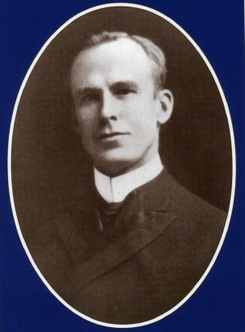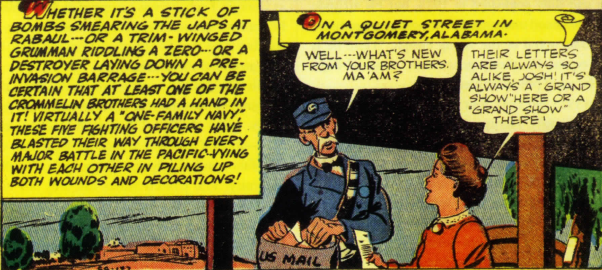|
On the cover: Lt. Richard Crommelin, one of the five Crommelin brothers, pictured in the cockpit of his Hellcat fighter, c. 1944. (Courtesy Naval Historical Center, Washington, D.C.)
|
FEATURE ABSTRACTS
Places in Peril
By the Alabama Historical Commission and the Alabama Preservation Alliance
Endangered Historic Landmarks Committee
The 1997 list of the most endangered historic sites in Alabama includes a covered bridge, a train depot, the remains of an early ironwork, and even an entire town. As part of the effort to raise awareness of endangered properties around the state, the "Places in Peril" listing is published each year in the fall issue of Alabama Heritage. The 1997 "Places in Peril" are: The City of Bridgeport; New Empire Theatre, Montgomery (demolished August 1997, prior to publication of list); Old Greene County Courthouse Complex, Eutaw; Slave Quarters, Statewide; Melton Hollow, Lauderdale County; Salem-Shotwell Covered Bridge, Lee County; Brierfield Furnace, Brierfield Ironworks Historical State Park, Bibb County; Vicksburg and Brunswick Depot, Eufaula; Historic Mill Villages, Statewide; Copeland House, Blount County; Nat King Cole House/Belaire Neighborhood, Montgomery.
Additional Information
The following articles in the Encyclopedia of Alabama will also be of interest:
Multimedia:
About the AHC/APA EHLC
The fourth annual listing of Places in Peril was prepared by a committee of preservationists from the Alabama Historical Commission, a state agency, and the Alabama Preservation Alliance, a private, nonprofit preservation organization. The committee made its selections after reviewing the extensive listings on the Preservation Watch List maintained by the commission as well as nominations from the general public.
Among those who participated in the selection process and/or the preparation of the article are Robert Gamble, Suzanne Wolfe, Devereaux Bemis, Doug Purcell, Jeff Mansell, Mary Elizabeth Johnson Huff, Camille Bowman, Ed Hooker, Ellen Mertins, Nathan Farris, Elizabeth Ann Brown, Mary Shell, Jim Parker, Tara Lanier, and Jennifer Horne.
The update on previously listed endangered properties was prepared with the assistance of the staffs of the Alabama Historical Commission, the Tuscaloosa Heritage Commission, and the Mobile Historic Development Commission. Ed Hooker of the Alabama Historical Commission prepared the endangered landmarks exhibit scheduled to tour the state for the coming year. To arrange for the exhibit to travel to your area or to nominate an endangered property for a future list, send information to Endangered Historic Landmarks, Alabama Historical Commission, 468 South Perry Street, Montgomery, Alabama 36130 (FAX 334-240-3477) or call 334-242-3184. All nominations must be accompanied by at least one good-quality photograph.
By the Alabama Historical Commission and the Alabama Preservation Alliance
Endangered Historic Landmarks Committee
The 1997 list of the most endangered historic sites in Alabama includes a covered bridge, a train depot, the remains of an early ironwork, and even an entire town. As part of the effort to raise awareness of endangered properties around the state, the "Places in Peril" listing is published each year in the fall issue of Alabama Heritage. The 1997 "Places in Peril" are: The City of Bridgeport; New Empire Theatre, Montgomery (demolished August 1997, prior to publication of list); Old Greene County Courthouse Complex, Eutaw; Slave Quarters, Statewide; Melton Hollow, Lauderdale County; Salem-Shotwell Covered Bridge, Lee County; Brierfield Furnace, Brierfield Ironworks Historical State Park, Bibb County; Vicksburg and Brunswick Depot, Eufaula; Historic Mill Villages, Statewide; Copeland House, Blount County; Nat King Cole House/Belaire Neighborhood, Montgomery.
Additional Information
The following articles in the Encyclopedia of Alabama will also be of interest:
Multimedia:
About the AHC/APA EHLC
The fourth annual listing of Places in Peril was prepared by a committee of preservationists from the Alabama Historical Commission, a state agency, and the Alabama Preservation Alliance, a private, nonprofit preservation organization. The committee made its selections after reviewing the extensive listings on the Preservation Watch List maintained by the commission as well as nominations from the general public.
Among those who participated in the selection process and/or the preparation of the article are Robert Gamble, Suzanne Wolfe, Devereaux Bemis, Doug Purcell, Jeff Mansell, Mary Elizabeth Johnson Huff, Camille Bowman, Ed Hooker, Ellen Mertins, Nathan Farris, Elizabeth Ann Brown, Mary Shell, Jim Parker, Tara Lanier, and Jennifer Horne.
The update on previously listed endangered properties was prepared with the assistance of the staffs of the Alabama Historical Commission, the Tuscaloosa Heritage Commission, and the Mobile Historic Development Commission. Ed Hooker of the Alabama Historical Commission prepared the endangered landmarks exhibit scheduled to tour the state for the coming year. To arrange for the exhibit to travel to your area or to nominate an endangered property for a future list, send information to Endangered Historic Landmarks, Alabama Historical Commission, 468 South Perry Street, Montgomery, Alabama 36130 (FAX 334-240-3477) or call 334-242-3184. All nominations must be accompanied by at least one good-quality photograph.
To read about more places in peril, click here for our Places in Peril blog.
The Crommelin Brothers
By John B. Scott, Jr.
History-making seemed to come naturally to the Crommelin boys of Wetumpka, Alabama, both at sea and in the air. The five brothers made their mark in World War II, earning a series of medals and in the process becoming one of the most decorated families in naval history. Author John B. Scott, Jr., interweaves the lives and heroic acts of the Crommelin brothers with the history of the naval battles that took place in the Pacific theatre in World War II. Time magazine dubbed the Crommelin brothers "The Indestructibles" for their amazing escapes from death, but it wasn’t long before this was proved, sadly, untrue. Within three months of each other, two of the brothers, Richard and Charles, were killed in mid-air collisions with other navy planes, and "the fleet’s most famous flying family" was broken up. A monument to the Crommelins in Battleship Park in Mobile, Alabama, commemorates their bravery.
Additional Information
Multimedia:
About the Author
Since retiring from active practice with the law firm of Capell, Howard, Knabe & Cobbs, Montgomery native John Scott has been writing on Alabama's history and countryside. This is his second article for Alabama Heritage. His previous contribution, on the old Clay County resort of Clairmont Springs, appeared in the fall of 1996. Memories of the Mount, Scott's history of Mt. Meigs, Alabama, was published in 1993 by Black Belt Press and received the C.J. Coley Award from the Alabama Historical Association.
The author wishes to thank the various members of the Crommelin family who assisted with the article and also former navy fighter pilot Cdr. William H. "Boots" Pierce, Jr., USN (Ret.) for his advice and insights. Thanks are also due to the United States Naval Academy, the National Institute, and the Naval Aviation Museum for the materials they furnished.
By John B. Scott, Jr.
History-making seemed to come naturally to the Crommelin boys of Wetumpka, Alabama, both at sea and in the air. The five brothers made their mark in World War II, earning a series of medals and in the process becoming one of the most decorated families in naval history. Author John B. Scott, Jr., interweaves the lives and heroic acts of the Crommelin brothers with the history of the naval battles that took place in the Pacific theatre in World War II. Time magazine dubbed the Crommelin brothers "The Indestructibles" for their amazing escapes from death, but it wasn’t long before this was proved, sadly, untrue. Within three months of each other, two of the brothers, Richard and Charles, were killed in mid-air collisions with other navy planes, and "the fleet’s most famous flying family" was broken up. A monument to the Crommelins in Battleship Park in Mobile, Alabama, commemorates their bravery.
Additional Information
- Bruce, Lt. Cdr. Rov W. USNR (Ret.), and Lt. Cdr. Charles R. Leonard, USN (Ret.) Crommelin's Thunderbirds: Air Group 12 Strikes the Heart of Japan. (The Naval Institute Press, 1994).
- Cagle, Vice Adm. H W., USN (Ret.), "The Crommelin Brothers Five." Naval Aviation Museum Foundation 2:9 (Fall 1988).
- Keegan, John. The Price of Admiralty: The Evolution of Naval Warfare. (Viking Penguin Inc., 1989).
- Morison, Samuel Eliot Morison. History of United States Naval Operations in World War II. (Little, Brown, 1947-62).
- Stafford, Cdr. Edward P. Stafford, USN. The Big E: The Story of the USS Enterprise. (Random House, 1962).
- _________ . "Saving Carrier Aviation-1949 Style." Proceedings (U.S. Naval Institute) 116:1 (Januarv 1990).
- Tillman, Barrett. Hellcat: The F6F in World War II (Naval Institute Press, 1979).
Multimedia:
About the Author
Since retiring from active practice with the law firm of Capell, Howard, Knabe & Cobbs, Montgomery native John Scott has been writing on Alabama's history and countryside. This is his second article for Alabama Heritage. His previous contribution, on the old Clay County resort of Clairmont Springs, appeared in the fall of 1996. Memories of the Mount, Scott's history of Mt. Meigs, Alabama, was published in 1993 by Black Belt Press and received the C.J. Coley Award from the Alabama Historical Association.
The author wishes to thank the various members of the Crommelin family who assisted with the article and also former navy fighter pilot Cdr. William H. "Boots" Pierce, Jr., USN (Ret.) for his advice and insights. Thanks are also due to the United States Naval Academy, the National Institute, and the Naval Aviation Museum for the materials they furnished.
 Draffus Hightower (1899-1993), photographed here studying an antique music box, was a shy, quiet man and a voracious reader who found almost any subject fascinating. In the mid-1930's, he turned his gaze to the world around him, which he documented with his camera for the next thirty years.
Draffus Hightower (1899-1993), photographed here studying an antique music box, was a shy, quiet man and a voracious reader who found almost any subject fascinating. In the mid-1930's, he turned his gaze to the world around him, which he documented with his camera for the next thirty years.
D.L. Hightower’s Photographs of a Vanishing World
By Michael V. R. Thomason
A Clayton, Alabama, resident and the former owner of Hightower Chevrolet, Draffus Hightower was known more for his hobby of taking photographs of local people and places than for his career. Now, Hightower’s photographs of the vanishing rural culture of Barbour County serve as an important historical record for current and future generations. In an excerpt from his book, To Remember a Vanishing World: D.L. Hightower’s Photographs of Barbour County, Alabama, c. 1930-1965, Michael V. R. Thomason examines the life of Draffus Hightower and the historic record his photos have left behind. After his father’s death in 1931, Hightower committed himself to preserving the disappearing culture of his youth. In addition to his more candid photos, Hightower often photographed community events like weddings and funerals. From 1936 on, he took hundreds of portraits of the people of Barbour County, which proved to be his greatest record of the culture he sought to preserve.
Additional Information
About the Author
Michael Thomason is a professor of history and director of University Archives, University of South Alabama, where he has been on the faculty since 1970. Originally from Florida, Thomason has a B.A. from Sewanee and an M.A./Ph.D. from Duke University. Long interested in old photographs and the photographers who made them, he has been the author or co-author of several books of historic photographs.
Thomason reports that he felt especially drawn to Draffus Hightower after studying his work, and he now believes that Hightower is one of Alabama's and the South's finest photographers.
To Remember a Vanishing World: D.L. Hightower's Photographs of Barbour County, Alabama, c. 1910-1965 will be published this fall by the Historic Chattahoochee Commission. The book sells for $29.95, plus $4 shipping and handling. For more information, or to order a copy, contact: Historic Chattahoochee Commission, P. O. Box 33, Dept. AH, Eufaula, Alabama 36072-0033. Phone: (334) 687-9755; FAX: (334) 687-6631.
By Michael V. R. Thomason
A Clayton, Alabama, resident and the former owner of Hightower Chevrolet, Draffus Hightower was known more for his hobby of taking photographs of local people and places than for his career. Now, Hightower’s photographs of the vanishing rural culture of Barbour County serve as an important historical record for current and future generations. In an excerpt from his book, To Remember a Vanishing World: D.L. Hightower’s Photographs of Barbour County, Alabama, c. 1930-1965, Michael V. R. Thomason examines the life of Draffus Hightower and the historic record his photos have left behind. After his father’s death in 1931, Hightower committed himself to preserving the disappearing culture of his youth. In addition to his more candid photos, Hightower often photographed community events like weddings and funerals. From 1936 on, he took hundreds of portraits of the people of Barbour County, which proved to be his greatest record of the culture he sought to preserve.
Additional Information
- Bourke-White, Margaret and Erskine Caldwell. You Have Seen Their Faces (Viking Press, 1937).
- Evans, Walker. Photographs for the Farm Security Administration, 1935-38. (Da Capo Press, 1975 [1938]).
- Rothstein, Arthur. The Depression Years as Photographed by Arthur Rothstein. (Dover, 1978)
- Stryker, Roy Emerson and Nancy Wood. In This Proud Land: America 1935-1943, As Seen in the FSA Photographs (Graphic Society Ltd., 1973).
About the Author
Michael Thomason is a professor of history and director of University Archives, University of South Alabama, where he has been on the faculty since 1970. Originally from Florida, Thomason has a B.A. from Sewanee and an M.A./Ph.D. from Duke University. Long interested in old photographs and the photographers who made them, he has been the author or co-author of several books of historic photographs.
Thomason reports that he felt especially drawn to Draffus Hightower after studying his work, and he now believes that Hightower is one of Alabama's and the South's finest photographers.
To Remember a Vanishing World: D.L. Hightower's Photographs of Barbour County, Alabama, c. 1910-1965 will be published this fall by the Historic Chattahoochee Commission. The book sells for $29.95, plus $4 shipping and handling. For more information, or to order a copy, contact: Historic Chattahoochee Commission, P. O. Box 33, Dept. AH, Eufaula, Alabama 36072-0033. Phone: (334) 687-9755; FAX: (334) 687-6631.
DEPARTMENT ABSTRACTS
 William H. Skaggs (1861-1947), the colorful mayor of Talladega, inaugurated many civic improvements- waterworks, public schools, a fire protection company- but he reguarded the day he put the sewer under the railroad tracks as one of the high points of his political career. (Courtesy Alabama Department of Archives and History.)
William H. Skaggs (1861-1947), the colorful mayor of Talladega, inaugurated many civic improvements- waterworks, public schools, a fire protection company- but he reguarded the day he put the sewer under the railroad tracks as one of the high points of his political career. (Courtesy Alabama Department of Archives and History.)
Notes on Alabama Law
The Talladega Sewer War, 1890
By Paul M. Pruitt, Jr.
William H. Skaggs (1861-1947), the colorful mayor of Talladega, inaugurated many civic improvements--waterworks, public schools, a fire protection company--but he regarded the day he put the sewer under the railroad tracks as one of the high points of his political career. This high point came after an extended battle with the railroad company, and may well have cost Skaggs his fourth term as mayor, but he regarded the sewer as a major contribution to the civic life of Talladega.
Additional Information
The following article in the Encyclopedia of Alabama will also be of interest:
About the Author
Paul M. Pruitt, Jr., is Special Collections Librarian, University of Alabama School of Law.
The Talladega Sewer War, 1890
By Paul M. Pruitt, Jr.
William H. Skaggs (1861-1947), the colorful mayor of Talladega, inaugurated many civic improvements--waterworks, public schools, a fire protection company--but he regarded the day he put the sewer under the railroad tracks as one of the high points of his political career. This high point came after an extended battle with the railroad company, and may well have cost Skaggs his fourth term as mayor, but he regarded the sewer as a major contribution to the civic life of Talladega.
Additional Information
The following article in the Encyclopedia of Alabama will also be of interest:
About the Author
Paul M. Pruitt, Jr., is Special Collections Librarian, University of Alabama School of Law.
The Nature Journal
British Soldiers (And Other Lichens)
By L.J. Davenport
Ubiquitous, but often overlooked, lichens inhabit some of the harshest environments on earth. For most of human history, scientists have treated lichens as single plants. We now know, however, that a lichen is actually a composite creature--part fungus and part alga, but with characteristics of its own.
About the Author
Larry Davenport is a professor of biology at Samford University, Birmingham, Alabama.
British Soldiers (And Other Lichens)
By L.J. Davenport
Ubiquitous, but often overlooked, lichens inhabit some of the harshest environments on earth. For most of human history, scientists have treated lichens as single plants. We now know, however, that a lichen is actually a composite creature--part fungus and part alga, but with characteristics of its own.
About the Author
Larry Davenport is a professor of biology at Samford University, Birmingham, Alabama.
Southern Architecture and Preservation
Lighting Planters' Lives
By Lee W. Rahe
As late as the middle of the nineteenth century, candles, because they were costly, were used sparingly even in the homes of Alabama's wealthiest planters. Lamps, too, were expensive as was the fuel they consumed. This article examines the variety of methods used for lighting houses during the time period.
Additional Information
The following items in the Encyclopedia of Alabama will also be of interest:
About the Author
Lee Rahe is an authority on the decorative arts of the antebellum South.
Lighting Planters' Lives
By Lee W. Rahe
As late as the middle of the nineteenth century, candles, because they were costly, were used sparingly even in the homes of Alabama's wealthiest planters. Lamps, too, were expensive as was the fuel they consumed. This article examines the variety of methods used for lighting houses during the time period.
Additional Information
The following items in the Encyclopedia of Alabama will also be of interest:
About the Author
Lee Rahe is an authority on the decorative arts of the antebellum South.

